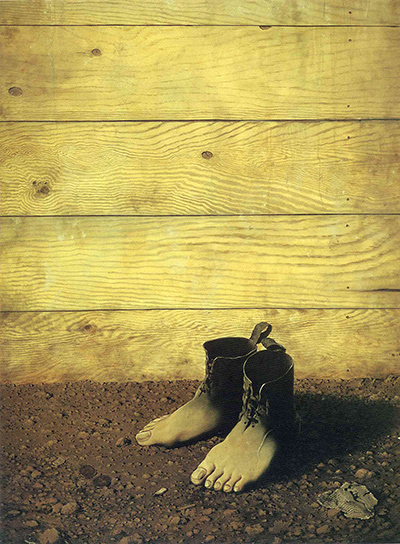The Red Model was painted in 1935. This oil on canvas work is typical of Magritte’s style, combining the ordinary with the extraordinary.
The subject of The Red Model is a pair of dirty boots, covered in dust, changing into a pair of feet at the end. The wood in the background, the dirt stones and the feet/boots themselves, are all painted in almost photographic detail. This gives the impression that what we are seeing is, disconcertingly, real. Many of his works depict completely different images in an unusual situation. For example, his painting “Time Transfixed” shows a train emerging from a fireplace. In contrast, “The Red Model” is one of a number of his paintings that displays connecting objects, albeit in an unexpected way. Another example of this connection theme is "Elective Affinities," painted in 1933, which depicts a giant egg inside a bird cage.
The image of feet and boots was a favourite of Magritte’s, and one which he returned to in a number of subsequent paintings. In many ways, this work plays with our preconception of what we expect to see. In everyday life we would expect to see feet or boots, but not at the same time. Under no circumstances would we see one transforming into the other. Even the painting’s title challenges our assumptions, and bears no relation to the work itself. Where, or what, is the red model? Again, what we expect to see and what we actually see has no connection. This is a common theme running throughout his work. In many of Magritte' paintings, he plays with words and images. His work "The Treachery of Images" is a painting of a pipe, with the words "This is not a pipe" written underneath. Magritte argued, correctly, that it is a picture not a pipe.
So, what does the painting, “The Red Model," actually mean? Magritte, when describing his paintings, said “they evoke mystery,” and “mystery means nothing.” Therefore, perhaps we should not look for a meaning. Alternatively, perhaps Magritte's intention is to, initially, confuse. Are the boots changing into feet, or the feet changing to boots? Does this matter? This confusion forces the viewer to consider, more closely, what they are actually seeing, and draw their own conclusions as to the meaning of the painting. Much of his work requires more deliberation than we, at first, assume. What, at first appear to be mundane objects, become much more interesting when viewed though the eyes of Magritte. This is certainly the case with "The Red Model," where the simple image of boots and feet, can be unsettling, disturbing, and thought-provoking.
Rene Magritte was born in Belgium in 1898. He was a surrealist artist, with a prolific output, painting approximately 1,600 works of art, before his death in 1967. Magritte’s work still remains popular, and can be seen in many forms, to this day. A large number of his works have been reproduced as posters, and used in album covers. His influence can also be seen in many books and movies. When struggling as an artist, to supplement his income, he formed an advertising agency with his brother. So, it is not surprising to see that many of his images appearing in modern-day advertisements. He began his artistic career as an Impressionist but changed to Surrealism in 1926. His first painting, in this style, was titled "The Lost Jockey." He exhibited his work to the public, for the first time, a year later. The exhibition was poorly received. As a direct result of this, he moved to Paris. Here he met fellow surrealists Salvador Dali, and Max Ernst. After spending three years in France, without enjoying any acclaim for his work, he returned to Belgium in 1930.




